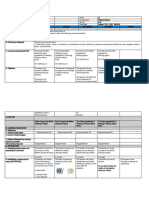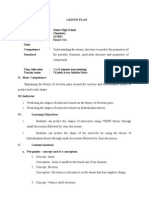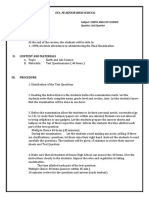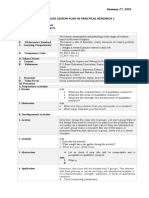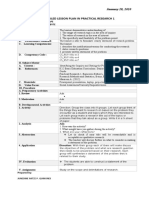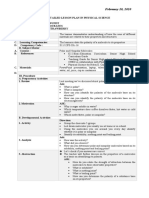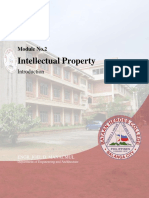February 21, 2020: Intermolecular Forces
February 21, 2020: Intermolecular Forces
Uploaded by
Gerald Jhim de UbaldoCopyright:
Available Formats
February 21, 2020: Intermolecular Forces
February 21, 2020: Intermolecular Forces
Uploaded by
Gerald Jhim de UbaldoOriginal Title
Copyright
Available Formats
Share this document
Did you find this document useful?
Is this content inappropriate?
Copyright:
Available Formats
February 21, 2020: Intermolecular Forces
February 21, 2020: Intermolecular Forces
Uploaded by
Gerald Jhim de UbaldoCopyright:
Available Formats
February 21, 2020
SEMI-DETAILED LESSON PLAN IN PHYSICAL SCIENCE
8:45 – 9:45 Grade 12 – WUNDT
11:00 – 12:00 Grade 12 - SOCRATES
2:00 – 3:00 Grade 12 – STRAWBERRY
I. Objectives
A. Content Standard: The learner demonstrates understanding of how the uses of different
materials are related to their properties and structures.
B. Performance Standard:
C. Learning Competencies: The learners:
1. Explain how the uses of the following materials depend on their
properties:
a. medical implants, prosthesis
b. sports equipment
c. electronic devices
d. construction supplies for buildings and furniture
e. household gadgets
2. Explain how the properties of the above materials are determined
by their structure
D. Competency Code : S11/12PS-IIId-e-20
S11/12PS-IIId-e21
II. Subject Matter
A. Content : How the properties of matter relate to their chemical structure
B. References: K12 Basic Education Curriculum Senior High School
Curriculum Guide
Teaching Guide for Senior High school Physical Science by
CHED in collaboration with Philippine Normal university
Physical Science by Helen E. Caintic, Ph.D.
C. Materials: PowerPoint presentation, laptop, television, chalk, board, picture,
III. Procedure
A. Preparatory Activities
1. Review The learners will be asked about their past learnings on the
previous topic (intermolecular forces) but it is going to be in
a form of a game (4pics 1word). Words to review are:
Vapor, Melting Point, Solubility, Surface Tension
What are the effects of intermolecular forces on the properties of
substances?
2. Motivation *First guide question
The teacher shows the class a single strand of walis tingting. Ask for
its uses and encourage creative answers. This can be a fun interactive
activity for the class.
Next, show a bundle of walis tingting and ask the learners its uses. At
the end of the activity, help the learners realize that the structure of
a material relates to its properties and eventual uses.
CONCEPT BRIDGING: the teacher must give the learners an idea that
everybody may employ engineering in daily materials that they use.
B. Developmental Activities
(Note: May always have Individual, Pair, and Peer Activities)
1. Activity *Second guide question
GROUP ACTIVITY # 1: STRING ENGINEERING
Present a dilemma to learners of making a piece of string
strong enough to lift a 3 kg weight. On its current state, the
string can only lift a portion of the weight before it breaks.
The learners need to figure out how to make it stronger.
Time limit: Project making: 10 minutes
Give the learners several material options to work:
1. More string (maximum amount of 6 meters) - learners may
opt to braid
February 21, 2020
2. Tape (maximum of 3 meters) - learners can wrap the string
with it
3. Glue (maximum of 1/2 cup) – learners may try to stiffen the
string
4. Rubber bands (10 pieces) - learners may try to mix materials
5. Others
The learners can do various things with the string. The
only limitation is that they must make the string strong enough
to lift a 3 kg weight and that it must be at least 1/2 meter in
length.
The initial string can be yarn, pisi, thin twine, paper
twine, etc. as long as it is a weak string that the learners can
“engineer” to make stronger. The weight may also be changed
to practical objects such as a heavy pot that needs to be hanged,
etc.
CONCEPT BRIDGING: The teacher must be abe to eplain to
the learners that when the structure of materials are adjusted or
engineered the properties and the uses are changed as well.
*third guide question
GROUP ACTIVITY # 2 GallerRealia WALK
*the class will ten again be grouped to 5
*a leader, reporter and a documenter will first be seleted in the
group
*rules will be set properly first
The learners will then be again grouped into 5. They will be
asked to roam by group and to the corresponding group of
pictures and some realia (medical implants, prosthesis, sports
equipment, electronic devices , construction supplies for
buildings and furniture, household gadgets) strategically
scattered around the classroom. After the gallery walk the
students wil be tasked to discuss among themselves using the
folowing guide questions/requirements, eachgroup will be given
realias/ set of pictures to work on
Ask the learners to find the following:
- chemical formula of the material
- structure of the material
- properties and uses
- how the material is manufactured
- historical development (if available)
*after the brainstorming, the groups will have to present their
outputs and report it in front of the class and will also be
processed by other groups
CONCEPT BRIDGING: the teacher shoud be able to supply
lacking and needed information after each group discusses
their findings
The learners will have to analyze and rationalize these GUIDE
2. Analysis QUESTIONS presented before each activity:
Do you believe that everybody practices engineering?
As students, will you be able to engineer materials and its
uses?
When engineering is applied does it always alter the
properties and uses of the resulting material?
February 21, 2020
*In a mini discussion the teacher should be able to summarize
3. Abstraction the topic by making students answer the question:
What are the various materials that have been engineered
throughout history and improved the way we do things?
How does chemistry played an important role in the
understanding and development of these materials?
In the engineering and restructuring of materials, does
the property always change?
And what happens to the result?
Does it become helpful to society or not?
(In this concept building part of the lesson the teacher may
present other information not included during the activities.)
Show a video clip about Filipino inventors. Have the learners watch a
4. Application video about: Filipino Inventor Plastic to Fuel
(https://www.youtube.com/watch?v=YMIQCEuNIpE)
ASK:
What realization can they get from the video?
Does the property of a material determine its structure?
Do finding new inventions and innovative ways improve the
way we do things in everyday life?
FILLING THE TABLES
IV. Evaluation In a ½ sheet of paper the class will be completing a table flashed
on the screen and as follows:
MATERIALS SPECIFIC EX. PROPERTY USES
medical
implants,
prosthesis
sports
equipment
electronic
devices
construction
supplies for
buildings and
furniture
household
gadgets
V. Assignment Study on the biological macromolecules.
VI. Remarks Not executed because I am in official travel to Division Office.
Prepared by:
JUNEDINE MITZE P. QUINONES
You might also like
- Group 6 - Biomolecules - Adaptive Teaching GuideDocument4 pagesGroup 6 - Biomolecules - Adaptive Teaching GuideAndrea CariñoNo ratings yet
- DLL Physical ScienceDocument20 pagesDLL Physical ScienceRucelle Mae Fernandez Arboleras100% (2)
- Poblacion Bagumbayan, Sultan KudaratDocument2 pagesPoblacion Bagumbayan, Sultan KudaratSheena DalguntasNo ratings yet
- DLL Earth & Life Science Week 5 - (September 25 - 29, 2023)Document4 pagesDLL Earth & Life Science Week 5 - (September 25 - 29, 2023)JERRY, JR. JUGARNo ratings yet
- Grade 11 Physical Science Course of StudyDocument3 pagesGrade 11 Physical Science Course of StudyJobeth Presto AlonzoNo ratings yet
- Physical Science DLP Q1W8Document6 pagesPhysical Science DLP Q1W8JennyMaeAguilarMeruNo ratings yet
- Q3 Q4 LEAST LEARNED Physical ScienceDocument2 pagesQ3 Q4 LEAST LEARNED Physical ScienceJoy AlcantaraNo ratings yet
- 2.1 Energy Flow in EcosystemDocument1 page2.1 Energy Flow in Ecosystempeisuanyap100% (1)
- Physical Science DLP Q1W1Document6 pagesPhysical Science DLP Q1W1JennyMaeAguilarMeruNo ratings yet
- The Formation of The Universe and The Solar System: Grade 12 Daily Lesson LogDocument3 pagesThe Formation of The Universe and The Solar System: Grade 12 Daily Lesson LogkimberlynNo ratings yet
- Summative Test 4 - PsDocument4 pagesSummative Test 4 - PsKennedy Fieldad VagayNo ratings yet
- Physics Lesson Plan: Goal(s) /PLO(s)Document3 pagesPhysics Lesson Plan: Goal(s) /PLO(s)Delson SonNo ratings yet
- LT IIbd 7Document3 pagesLT IIbd 7Evangelene Esquillo Sana100% (1)
- DLL PHY SCI Week 11Document5 pagesDLL PHY SCI Week 11kent100% (2)
- Lesson Guide in Earth and Life Science I. Objectives: Geologic Processes That Occur Within The EarthDocument3 pagesLesson Guide in Earth and Life Science I. Objectives: Geologic Processes That Occur Within The EarthJT SaguinNo ratings yet
- Lesson Plan 2 MetamorphicDocument9 pagesLesson Plan 2 MetamorphicSahada KanapiyaNo ratings yet
- Dlp-Life Science - Mhelds Revised by AidenDocument11 pagesDlp-Life Science - Mhelds Revised by AidenImelda BayonaNo ratings yet
- Lesson Plan Intermolecular Forces BaruDocument30 pagesLesson Plan Intermolecular Forces BaruIrvan AdisthaNo ratings yet
- DLL FormatDocument3 pagesDLL FormatANDELYN100% (1)
- DLL Els Quarter 2 Week 7Document3 pagesDLL Els Quarter 2 Week 7alyssa.ballonNo ratings yet
- Physical Science DLPDocument7 pagesPhysical Science DLPDhulz IlegnaNo ratings yet
- Relative Dating Lesson PlanDocument5 pagesRelative Dating Lesson PlanAnalyn EnsanoNo ratings yet
- EDLL L25 To 35Document43 pagesEDLL L25 To 35Marjorie BrondoNo ratings yet
- DLL June 17-21-19-ElsDocument3 pagesDLL June 17-21-19-ElsCristina MaquintoNo ratings yet
- Budget of Work Earth and Life Science MelcDocument2 pagesBudget of Work Earth and Life Science MelcKianna Marie VitugNo ratings yet
- SHSCOTDocument3 pagesSHSCOTJassy Christine CalacatNo ratings yet
- 1 DLL Gen BioDocument3 pages1 DLL Gen BioGretchenNo ratings yet
- PHYSCI - Q3 - WEEK 1 - LE - v1Document7 pagesPHYSCI - Q3 - WEEK 1 - LE - v1cristina maquintoNo ratings yet
- Earth Sci DLL WEEK 5 FinalDocument4 pagesEarth Sci DLL WEEK 5 FinalmaricarNo ratings yet
- Prepared By: Christian Martin Paranaque National High School (MAIN)Document6 pagesPrepared By: Christian Martin Paranaque National High School (MAIN)Arnel MetilloNo ratings yet
- 3rd Quarter - Research 1Document3 pages3rd Quarter - Research 1Hpesoj SemlapNo ratings yet
- Naguilian Senior High School: Weekly Home Learning Plan Earth and Life Science SCHOOL YEAR 2020-2021Document2 pagesNaguilian Senior High School: Weekly Home Learning Plan Earth and Life Science SCHOOL YEAR 2020-2021nicky tampocNo ratings yet
- Q4 - 3rd SummativeDocument2 pagesQ4 - 3rd SummativeRowenickNo ratings yet
- Weekly Home Learning Plan Grade 11 Week 3-Quarter 1 October 19-23, 2020 Day & Time Learning Area Learning Competency Learning Tasks Mode of DeliveryDocument3 pagesWeekly Home Learning Plan Grade 11 Week 3-Quarter 1 October 19-23, 2020 Day & Time Learning Area Learning Competency Learning Tasks Mode of DeliveryLeo MagalonaNo ratings yet
- Table of Specification 1 Semester/ 2 Quarterly Assessment Grade 12 Subject: Physical ScienceDocument5 pagesTable of Specification 1 Semester/ 2 Quarterly Assessment Grade 12 Subject: Physical ScienceArlance Sandra Marie MedinaNo ratings yet
- Pretest in General Chemistry 2 MULTIPLE CHOICES: Read and Analyze The Statements and Questions Carefully. Identify The Best OptionDocument2 pagesPretest in General Chemistry 2 MULTIPLE CHOICES: Read and Analyze The Statements and Questions Carefully. Identify The Best OptionSalinas SalinasNo ratings yet
- DLL SHS Physical ScienceDocument20 pagesDLL SHS Physical ScienceGerah Arcayos BiñasNo ratings yet
- Monday Tuesday Wednesday Thursday FridayDocument6 pagesMonday Tuesday Wednesday Thursday FridayPretzelParkNo ratings yet
- DLL Science 4 q2 w10Document4 pagesDLL Science 4 q2 w10Eric D. ValleNo ratings yet
- Physical Science Exam Sample For 1st QuarterDocument2 pagesPhysical Science Exam Sample For 1st QuarterGabNo ratings yet
- Marinduque National High School: Department of Education MIMAROPA Region Isok 1, Boac, MarinduqueDocument4 pagesMarinduque National High School: Department of Education MIMAROPA Region Isok 1, Boac, MarinduqueMaria Joy VelascoNo ratings yet
- Earth and Life ScienceDocument2 pagesEarth and Life ScienceMaricar Cesista NicartNo ratings yet
- DLP Genchem1 Week1 Day1Document5 pagesDLP Genchem1 Week1 Day1Shena Ramyr CaboNo ratings yet
- DLP MotionDocument2 pagesDLP MotionfaithkathaabucejoNo ratings yet
- Exemplar Science Lesson Plan For Senior High School General Chemistry 1Document6 pagesExemplar Science Lesson Plan For Senior High School General Chemistry 1Arnel Metillo100% (1)
- LP Biological MacromoleculesDocument5 pagesLP Biological MacromoleculesWelfredo Jr YuNo ratings yet
- STEM - Gen Chem 1 and 2 CG - With Tagged Sci Equipment PDFDocument23 pagesSTEM - Gen Chem 1 and 2 CG - With Tagged Sci Equipment PDFAnonymous qZyYVNg0% (1)
- Physical Science DLL q2 (Week 4)Document2 pagesPhysical Science DLL q2 (Week 4)Esmale RyaNo ratings yet
- Week 1Document1 pageWeek 1Gen DeeNo ratings yet
- Daily - Lesson - Log - in - Earth sCIENCE 2020Document4 pagesDaily - Lesson - Log - in - Earth sCIENCE 2020Zllehb BhelayzNo ratings yet
- DLP PS 31-32Document2 pagesDLP PS 31-32Jose Benavente100% (1)
- PS LP 1st QuarterDocument10 pagesPS LP 1st QuarterJomark Rebolledo100% (2)
- Lesson 1 and 2: Properties of Matter: Rbi Script: General Chemistry 1 Prepared By: Donnafe M. AganonDocument2 pagesLesson 1 and 2: Properties of Matter: Rbi Script: General Chemistry 1 Prepared By: Donnafe M. Aganonbenjie panlicanNo ratings yet
- Learning Area Learning Delivery Modality: Week 1 Day 3Document6 pagesLearning Area Learning Delivery Modality: Week 1 Day 3MaricarDimasNo ratings yet
- Week 1 - Daily Lesson Log inSHS Life ScienceDocument3 pagesWeek 1 - Daily Lesson Log inSHS Life ScienceMaricarDimas100% (3)
- Dll-Types of Chemical RXNDocument23 pagesDll-Types of Chemical RXNLeny SantosNo ratings yet
- Learning - Plan - WEEK 5Document5 pagesLearning - Plan - WEEK 5Yakubu Ahmad RufaiNo ratings yet
- Science VDocument11 pagesScience VMarie Lorine EspesorNo ratings yet
- Q1 Science WK1 Day 3Document4 pagesQ1 Science WK1 Day 3monethNo ratings yet
- Student Teaching - Lesson Plan 1 2Document6 pagesStudent Teaching - Lesson Plan 1 2api-374140163No ratings yet
- Aba Ginoong MariaDocument2 pagesAba Ginoong MariaGerald Jhim de Ubaldo100% (1)
- Case Study Relationship of Ethics On EducationDocument5 pagesCase Study Relationship of Ethics On EducationGerald Jhim de UbaldoNo ratings yet
- Creative Nonfiction Unit 3 Lesson 1Document2 pagesCreative Nonfiction Unit 3 Lesson 1Gerald Jhim de UbaldoNo ratings yet
- Ej 1072682Document6 pagesEj 1072682Gerald Jhim de UbaldoNo ratings yet
- Empowerment Technologies 7Document2 pagesEmpowerment Technologies 7Gerald Jhim de UbaldoNo ratings yet
- LogreDocument92 pagesLogreGerald Jhim de UbaldoNo ratings yet
- Semi-Detailed Lesson Plan in Practical Research 1: January 27, 2020Document2 pagesSemi-Detailed Lesson Plan in Practical Research 1: January 27, 2020Gerald Jhim de Ubaldo100% (1)
- Semi-Detailed Lesson Plan in Practical Research 1: January 28, 2020Document1 pageSemi-Detailed Lesson Plan in Practical Research 1: January 28, 2020Gerald Jhim de UbaldoNo ratings yet
- Empowerment Technologies 10Document3 pagesEmpowerment Technologies 10Gerald Jhim de Ubaldo100% (1)
- February 10, 2020Document2 pagesFebruary 10, 2020Gerald Jhim de UbaldoNo ratings yet
- Empowerment Technologies 12Document2 pagesEmpowerment Technologies 12Gerald Jhim de UbaldoNo ratings yet
- Activity Sheets Experiment 1Document2 pagesActivity Sheets Experiment 1Gerald Jhim de UbaldoNo ratings yet
- 6c4b761a28b734fe93831e3fb400ce87.txtDocument48 pages6c4b761a28b734fe93831e3fb400ce87.txtGerald Jhim de UbaldoNo ratings yet
- Empowerment Technologies 3Document4 pagesEmpowerment Technologies 3Gerald Jhim de UbaldoNo ratings yet
- Empowerment Technologies 2Document2 pagesEmpowerment Technologies 2Gerald Jhim de UbaldoNo ratings yet
- Empowerment Technologies 1Document2 pagesEmpowerment Technologies 1Gerald Jhim de Ubaldo100% (1)
- Test Questionnaires in EmpowermentDocument5 pagesTest Questionnaires in EmpowermentGerald Jhim de UbaldoNo ratings yet
- Portfolio IN Physical Science: Department of Education Burauen Comprehensive National High School Senior High SchoolDocument1 pagePortfolio IN Physical Science: Department of Education Burauen Comprehensive National High School Senior High SchoolGerald Jhim de UbaldoNo ratings yet
- Types of Chemical ReactionDocument28 pagesTypes of Chemical ReactionGerald Jhim de UbaldoNo ratings yet
- DM No. 052, S. 2019Document10 pagesDM No. 052, S. 2019Gerald Jhim de UbaldoNo ratings yet
- LEC 1 - (WEEK 1) Understanding Culture, Society, and PoliticsDocument33 pagesLEC 1 - (WEEK 1) Understanding Culture, Society, and Politicssheela100% (3)
- Petrovoltaic Clock PDFDocument1 pagePetrovoltaic Clock PDFwroueaweNo ratings yet
- A13081368936508054e113d4 1695024462ANAVI JAITLEY 13288 UG Appointment Letter Others FTC G0 Fixed 20230916 143259 75954662365056f430f528891810190Document21 pagesA13081368936508054e113d4 1695024462ANAVI JAITLEY 13288 UG Appointment Letter Others FTC G0 Fixed 20230916 143259 75954662365056f430f528891810190Anavi JaitleyNo ratings yet
- Creativity and InnovationDocument7 pagesCreativity and InnovationFarìhà BabarNo ratings yet
- March 8, 2022 (Group 9A)Document7 pagesMarch 8, 2022 (Group 9A)An NguyenNo ratings yet
- Brecht 1 NotesDocument13 pagesBrecht 1 NotesDarby HarmonNo ratings yet
- The Invention GameDocument6 pagesThe Invention GameKELLY JOHANNA CUBILLOS VILLALBANo ratings yet
- Intellectual Property Law ReviewerDocument10 pagesIntellectual Property Law ReviewerAliyah Sanders100% (2)
- Lecture-2 (Innovation Management - An Inroduction)Document31 pagesLecture-2 (Innovation Management - An Inroduction)Amit PatelNo ratings yet
- ENTREPRENEURSHIPDocument6 pagesENTREPRENEURSHIPLENIE TABORNo ratings yet
- Filipino Inventors and Their InventionsDocument9 pagesFilipino Inventors and Their Inventionsgabosara298No ratings yet
- Unit 7:: Intellectual PropertyDocument52 pagesUnit 7:: Intellectual Propertyمحمد فائزNo ratings yet
- Pearl and Dean Vs SMI PDFDocument5 pagesPearl and Dean Vs SMI PDFAnonymous wDganZNo ratings yet
- Research Methodology & IPR - VTU Model Question Papers With AnswersDocument29 pagesResearch Methodology & IPR - VTU Model Question Papers With AnswersSuma BijapurNo ratings yet
- Running Head: Intellectual Property1: InstitutionDocument9 pagesRunning Head: Intellectual Property1: InstitutionJosphatNo ratings yet
- Speaking Questions BookDocument39 pagesSpeaking Questions Booksultonovasadbek321No ratings yet
- Introduction To Intellectual Property - Module 02Document12 pagesIntroduction To Intellectual Property - Module 02Joel ManacmulNo ratings yet
- L P THÊM Unit 5Document9 pagesL P THÊM Unit 5Hà QuyênNo ratings yet
- Social Sec v2Document58 pagesSocial Sec v2omsalma kamalNo ratings yet
- Winding Up CasesDocument26 pagesWinding Up CasesPCLS HNLU ChapterNo ratings yet
- Our World 4B Student Book PDFDocument144 pagesOur World 4B Student Book PDFangel01erasmusNo ratings yet
- 2 U3 W1 Pearl and WagnerDocument4 pages2 U3 W1 Pearl and Wagnergarysun585No ratings yet
- MIL 1Q Unified ExaminationDocument4 pagesMIL 1Q Unified ExaminationMaria Rizza LuchavezNo ratings yet
- Indonesia Inventors Day 2021Document21 pagesIndonesia Inventors Day 2021DeRa RahayoeNo ratings yet
- Reka Cipta Inovasi Kreativiti 08Document41 pagesReka Cipta Inovasi Kreativiti 08Fujii YuzyNo ratings yet
- PatentDocument19 pagesPatentKaleb SeekNo ratings yet
- Patent Law ProjectDocument15 pagesPatent Law Projectanchal singh yadavNo ratings yet
- Unit 4 FSQCDocument28 pagesUnit 4 FSQCvaralakshmi KNo ratings yet
- Q1 WS Science4 Lesson-1-Week-1Document11 pagesQ1 WS Science4 Lesson-1-Week-1Julieta PinteroNo ratings yet
- Patent U2Document4 pagesPatent U2Rajib Lochan BairiganjanNo ratings yet





